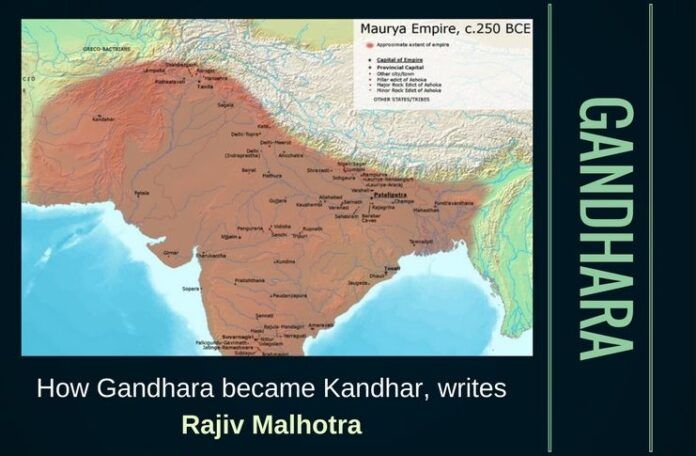
[dropcap color=”#008040″ boxed=”yes” boxed_radius=”8px” class=”” id=””]A[/dropcap]fghanistan’s epic history starts when it was an important region of ancient India called ‘Gandhara’. One of its most frequently mentioned cities in the world today is ‘Kandahar’, made infamous by the Taliban. The earlier name of the city was ‘Quandhar’, derived from the name of the region of Gandhara. Erstwhile home to Al-Qaeda today, it was always a strategic site, being on main Persian routes to Central Asia and India. Hence, it has a long history of conquests. Kandahar was taken by Alexander in 329 B.C.E., was surrendered by the Greek to Chandragupta in 305 B.C.E., and is dignified by a rock inscription of Asoka. It fell under Arab rule in the 7th century C.E., and under the Ghaznavids in the 10th. Kandahar was destroyed by Genghis Khan and again by the Turkic conqueror Timur, after which it was held by the Mughals. Mughal Emperor Babur built 40 giant steps up a hill, cut out of the solid limestone, leading to inscriptions recording details of his proud conquests. In 1747 it became the first capital of a unified Afghanistan.
Gandhara was the trade crossroad and cultural meeting place between India, Central Asia, and the Middle East.
Besides early reference in the Vedas, Ramayana and Mahabharata, Gandhara was the locus of ancient Indian-Persian interaction, a center of world trade and culture. It was a major Buddhist intellectual hub for centuries. The giant Buddhist statues recently destroyed by the Taliban were in Bamiyan, one of the important Buddhist cities of ancient times. Thousands of statues and stupas once dominated its landscape.
Ancient Gandhara
Gandharvas are first described in the Vedas as cosmic beings. Later literature describes them as a jati(community), and the later Natyasastra refers to their system of music as gandharva.
Gupt explains[i]:
“Gandharvas, as spoken of in Samhitas and later literature, had derived their name from a geographical people, the Gandharas… Most likely they belonged to Afghanistan (which still has a township called Kandhara)… It was perhaps at this time that the Gandharas raised the art of music to a great height. This region of the subcontinent at the time had become the locus of a great confluence of the musical traditions of the East and the Mediterranean. The very art, thus, came to be known by the name of the region and was so called by it even in the heartland of India. This name, gandharva, continued to be used for music for centuries to come. In the Vayu Purana one of the nine divisions of Bharatavarsa is called Gandharva.”
[dropcap color=”#008040″ boxed=”yes” boxed_radius=”8px” class=”” id=””]D[/dropcap]uring the Mahabharata period, the Gandhara region was very much culturally and politically a part of India. King Shakuni, brother of Gandhârî, fought with Pandavas in the famous epic Mahabharata. The battle was fought in Kurukshetra, in the heartland of India. Gandhârî was married to King Dhrtrastra. Exchanges between Gandhara and Hastinapur (Delhi) were well established and intense. Mehrgarh, located in this region and part of the Indus Valley civilization, is the oldest town excavated by archeologists (8000B.C.E) in the world.
Gandhara was the trade crossroad and cultural meeting place between India, Central Asia, and the Middle East. Buddhist writings mention Gandhara (which included Peshawar, Swat and Kabul Valleys) as one of the 16 major states of northern India at the time. It was a province of the Persian king Darius I in the fifth century B.C.E. After conquering it in the 4th century B.C.E., Alexander encountered the vast army of the Nandas in the Punjab, and his soldiers mutinied causing him to leave India.
Thereafter, Gandhara was ruled by the Maurya dynasty of India, and during the reign of the Indian emperor Ashoka (3rd century B.C.E.), Buddhism spread and became the world’s first religion across Eurasia, influencing early Christianity and East Asian civilizations. Padmasambhava, the spiritual and intellectual founder of the Indo-Tibetan Buddhism, was from Gandhara. Greek historian Pliny wrote that the Mauryans had a massive army; and yet, like all other Indian kingdoms, they made no attempt at overseas conquest.
Gandhara and Sind were considered parts of India since ancient times, as historian Andre Wink explains:
[dropcap color=”#008040″ boxed=”yes” boxed_radius=”8px” class=”” id=””]”F[/dropcap]rom ancient times both Makran and Sind had been regarded as belonging to India… It definitely did extend beyond the present province of Sind and Makran; the whole of Baluchistan was included, a part of the Panjab, and the North-West Frontier Province.”[ii]
“The Arab geographers, in effect, commonly speak of ‘that king of al-Hind…”[iii]
“…Sind was predominantly Indian rather than Persian, and in duration the periods that it had been politically attached to, or incorporated in, an Indian polity far outweigh Persian domination. The Maurya empire was extended to the Indus valley by Candragupta, laying the foundation of a great Buddhist urban-based civilization. Numerous Buddhist monasteries were founded in the area, and Takshashila became an important centre of Buddhist learning, especially in Ashoka’s time. Under the Kushanas, in the late first century A.D… international trade and urbanization reached unprecedented levels in the Indus valley and Purushapara (Peshawar) became the capital of a far-flung empire and Gandhara the second home of Buddhism, producing the well-known Gandhara-Buddhist art. In Purushapara, Kanishka is supposed to have convened the fourth Buddhist council and to have built the Kanishka Vihara, which remained a Buddhist pilgrimage center for centuries to come as well as a center for the dissemination of the religion to Central Asia and China… in conjunction with Hinduism, Buddhism survived in Sind until well into the tenth century.”[iv]
From 1st century C.E., emperor Kaniska I and his Kushan successors were acknowledged as one of the four great Eurasian powers of their time…
“Hiuen Tsang… was especially impressed by the thousand Buddhist monks who lived in the caves of Bamiyan, and the colossal stone Buddha, with a height of 53.5 m, then still decorated with gold. There is also evidence of devi cults in the same areas.”[v]
Shaivism was also an important ancient religion in this region, with wide influence. Wink writes:
“…Qandahar [modern Kandahar]…. was the religious center of the kingdom where the cult of the Shaivite god Zun was performed on a hilltop…”.[vi]
“…the god Zun or Zhun … shrine lay in Zamindawar before the arrival of Islam, set on a sacred mountain, and still existing in the later ninth century …. [The region was]… famous as a pilgrimage center devoted to Zun. In China the god’s temple became known as the temple of Su-na. …[T]he worship of Zun might be related to that of the old shrine of the sun-god Aditya at Multan. In any case, the cult of Zun was primarily Hindu, not Buddhist or Zoroastrian.”[vii]
“[A] connection of Gandhara with the polymorphic male god Shiva and the Durga Devi is now well-established. The pre-eminent character of Zun or Sun was that of a mountain god. And a connection with mountains also predominates in the composite religious configuration of Shiva, the lord of the mountain, the cosmic pivot and the ruler of time… Gandhara and the neighboring countries in fact represent a prominent background to classical Shaivism.”[viii]
From 1st century C.E., emperor Kaniska I and his Kushan successors were acknowledged as one of the four great Eurasian powers of their time (the others being China, Rome, and Parthia). The Kushans further spread Buddhism to Central Asia and China, and developed Mahayana Buddhism and the Gandhara and Mathura schools of art. The Kushans became affluent through trade, particularly with exports to Rome. Their coins and art are witness to the tolerance and syncretism in religion and art that prevailed in the region. The Gandhara school incorporated many motifs from classical Roman art, but the basic iconography remained Indian.[ix]
Ancient Taxila and Peshawar
[dropcap color=”#008040″ boxed=”yes” boxed_radius=”8px” class=”” id=””]G[/dropcap]andhara’s capital was the famous city of Takshashila. According to the Ramayana, the city was founded by Bharata, and named after his son, Taksha, its first ruler. Greek writers later shortened it to Taxila. The Mahabharata is said to have been first recited at this place. Buddhist literature, especially the jataka stories, mentions it as the capital of the Gandhara kingdom and as a great center of learning. Its ruins may be visited today in an hour’s taxi ride from Rawalpindi (Pakistan).
Taxila was strategically located at the 3-way junction of the great trade routes from eastern India (described by Megasthenes, as the “Royal Highway”), from western Asia, Kashmir and Central Asia. Greek historians accompanying Alexander described Taxila as “wealthy, prosperous, and well governed”. Soon after Alexander, Taxila was absorbed into the Maurya Empire as a provincial capital, lasting for three generations.
Andre Wink describes that this aspiration to conquer India had existed since the time of the Prophet…
The sage Apollonius of Tyana visited Taxila in the 1st century C.E., and his biographer described it as a fortified city with a symmetrical architecture, comparable in size to the most populous city of the ancient Assyrian Empire. Even a thousand years after Buddha, Chinese Buddhist pilgrim Fa-hsien described it as a thriving center of Buddhism. But by the time Hsuan-tsang visited from China in the 7th century C.E., Taxila had been destroyed by the Huns. Taxila was renowned as a center of learning.
During other times, the capital of Gandhara was Purusapura (abode of Purusha, the Hindu name for the Supreme Being), whose name was changed by Akbar to Peshawar. Near Peshawar are ruins of the largest Buddhist stupa in the subcontinent (2nd century C.E.), attesting to the enduring presence of Buddhism in the region. Purusapura is mentioned in early Sanskrit literature, in the writings of the classical historians Strabo and Arrian, and the geographer Ptolemy. Kaniska made Purusapura the capital of his Kushan empire (1st century C.E.). It was captured by the Muslims in C.E. 988.
Genocide Part 1: The Conquest of Sind
All this glorious past, and Asia’s civilization, changed forever with the bloody plunder of Sind by the Arabs starting in the 7th century:
“In 653-4, …a force of 6000 Arabs penetrated… To the shrine of Zun. The general broke off a hand from the idol and plucked out the rubies which were its eyes… The Arabs were now able to mount frequent plunder and slave expeditions as far as Ghazna, Kabul and Bamiyan… Arab raiding continued and was aimed at exacting tribute, plunder and slaves …Slaves and beasts remained the principal booty of the raids, and these were sent to the caliphate court in a steady stream.”[x]
Andre Wink describes that this aspiration to conquer India had existed since the time of the Prophet, as is evidenced by the sacred texts:
“… in the hadith collections the prophet Muhammad himself is credited with the aspiration of conquering India. Participants in the holy war against al-Hind [the Hindus] are promised to be saved from hell-fire… Thus also an eschatological work which is called the Kitab al-Fitan (‘Book of Trials’) credits Muhammad with saying that God will forgive the sins of the members of the Muslim army which will attack al-Hind, and give them victory.”[xi]
[dropcap color=”#008040″ boxed=”yes” boxed_radius=”8px” class=”” id=””]T[/dropcap]he plunder was also achieved by an ingenious system of leaving the prosperous population alone, so that they would continue to bring donations to the temples, and then the Muslims would loot these temples. In order to save their temple from destruction, many Hindu warriors refused to fight:
“An even greater part of the revenue of these rulers was derived from the gifts donated by pilgrims who came from all over Sind and Hind to the great idol (sanam) of the sun-temple at Multan… When Muhammad al-Qasim conquered Multan, he quickly discovered that it was this temple which was one of the main reasons for the great wealth of the town. He ‘made captives of the custodians of the budd, numbering 6000′ and confiscated its wealth, but not the idol itself – which was made of wood, covered with red leather and two red rubies for its eyes and wearing a crown of gold inlaid with gems –, ‘thinking it best to leave the idol where it was, but hanging a piece of cow’s flesh on its neck by way of mockery’. AI-Qasim built his mosque in the same place, in the most crowded bazaar in the center of the town. The possession of the sun-temple — rather than the mosque — is what in later times the geographers see as the reason why the local governors or rulers could hold out against the neighboring Hindu powers. Whenever an ‘infidel king’ marched against Multan and the Muslims found it difficult to offer adequate resistance, they threatened to break the idol or mutilate it, and this, allegedly, made the enemy withdraw. In the late tenth century however the Isma’ilis who occupied Multan broke the idol into pieces and killed its priests. A new mosque was then erected on its site…”[xii].
The concluding part of this post can be accessed here.
Bibliography:
[i] “Dramatic Concepts: Greek and Indian – A Study of Poetics & Natyasastra”, By Bharat Gupt. D.K. Printworld (P) Ltd., New Delhi, India, 1994. Pages 21-23.
[ii] “The Making of the Indo-Islamic World. Volume I – Early Medieval India and the Expansion of Islam 7th-11th Centuries”, by Andre Wink. Oxford University Press, New Delhi 1999. p.144-146.
[iii] Wink pp. 112-114.
[iv] Wink pp.148-149.
[v] Wink. pp. 117-118.
[vi] Wink pp. 112-114.
[vii] Wink p.118.
[viii] Wink p.119.
[ix] References on Gandhara are: John Marshall, Taxila, 3 vol. (1951, reprinted 1975), provides the most exhaustive material for the history and archaeological excavations of Taxila. Radha Kumud Mookerji, Ancient Indian Education. 4th ed. (1969), includes a comprehensive account of Taxila as a centre of learning. For a general study of Taxila as an ancient city, see Stuart Piggot, Some Cities of Ancient India (1945); B.N. Puri, Cities of Ancient India (1966); Ahmad Hasan Dani, The Historic City of Taxila (1986); and Saifur Rahman Dar, Taxila and the Western World (1984). Encyclopaedia Britannica. 1993. Vol. 11, pp. 585-586; Vol. 9, p. 321; Vol. 6, pp. 710-711; Vol. 21, p.41. “Students’ Britannica India”. Vol. 2, pp. 137-138. Vol. 5, p. 121-123.
[x] Wink p.120
[xi] Wink p.192-193.
[xii] Wink pp.187-188
- Part 2: Discussion between Dr. Swamy and Rajiv Malhotra - September 10, 2017
- Dr Subramanian Swamy In Conversation with Rajiv Malhotra - July 24, 2017
- P2 – Discussing the Digestion of Yoga with a White Hindu - July 3, 2017











gandhara is not kandahar …. gandhara was near peshawar or what is now the khyber pakthunwa region of pakistan – afghanistan border and it is originated from the word gandha due the spices and local herbs the locals use to trade with .. and kandahar is a corruption of the word iskandar or alexander in persian . the city of kandahar was founded by alexander when he took a reputed local fort and founded a city alexandria .. moreover Kandahar is in south Afganistan near the Persian border hence there where so many Mughal – Persian conflicts for the town BTW Kandahar is nearly 776 km from Peshawar the Ancient Gandhara region.
While going thru the article … it seems big confusion is created by years B C E and A D ? One person wrote and followed by others as copy cat Historians?
If Greek Arab, Mughals , King Ashoka, Chadrgupta, Budha etc the mixture of this really proves it is not a history but to misguide others? 300 BCE and so on so till Afghanistan was established ? Which labguage was in use ? Greek, arab, persian, Budha, Sanskrit? What is Pashtoo language or other tribal languages spoken by Afghan people till today?
So it is a fake History written and Name of Gandhari or Ghandhrv just added coincidentally ? How it is possible that thousand years Sanskrit language spoken by inhabitant of Ghandhar ( Qandhaar) have forgotten ? and sanskrit either was learned by Arab, Greek, Mughals?
Thousand books written in sanskrit are found but no other language speak or write about sanskrit? nor they mention about Mahabharta battle of Kurukshetra ? not even Arabic was spoken or other language ? So it is just to nullify the existence of Hindus in Himalaya Where Rishi, Muni till date are going for Pilgrimage and meditation . Western writers have ignored or feeling ashamed on such great knowledge books they have fabricated history and followed by other historians.
Even in modern india that region is source many singers dancers n actors.. From kapoor family to most of khans all can trace their origins to peshawar gandhar swat region
Excellent presentation of true facts of indian History Rajeev. Please enlighten us with more such research. I am glad people like you and French man Froncois Gautier are really giving the true facts of Indian history. History told or written by people like Habib(made famous recently by his award wasp tactics) are truly corrupted by calling people like Tipu Sultan as freedom fighters etc. Please Rajiv enlighten our children by writing TRUE Indian history to bee studied by our children.
Thank you for excellent research.History books authored and directed by people like Habib(recently famous for Awards Wapsi) did not correct interpretation of Indian History. Along with you there is another French man Froncois Gautier who is giving correct information of our History,please continue to give such great information. I think you people should completely re write Indian History and introduce such books to our children in Schools.
Rajeev Sir, really wonderful research, much to do more here. Thanks for your continuous effort, hope one day young mind like me will somehow contribute towards this.
Thank you for enlightening us with such wonderful information regarding India’s glorious history in such a concise and understandable way. I wonder why these facts find no mention in our school history books.
History books written by the Congress stooges need to be trashed and the true glorious history of India should be taught in schools.